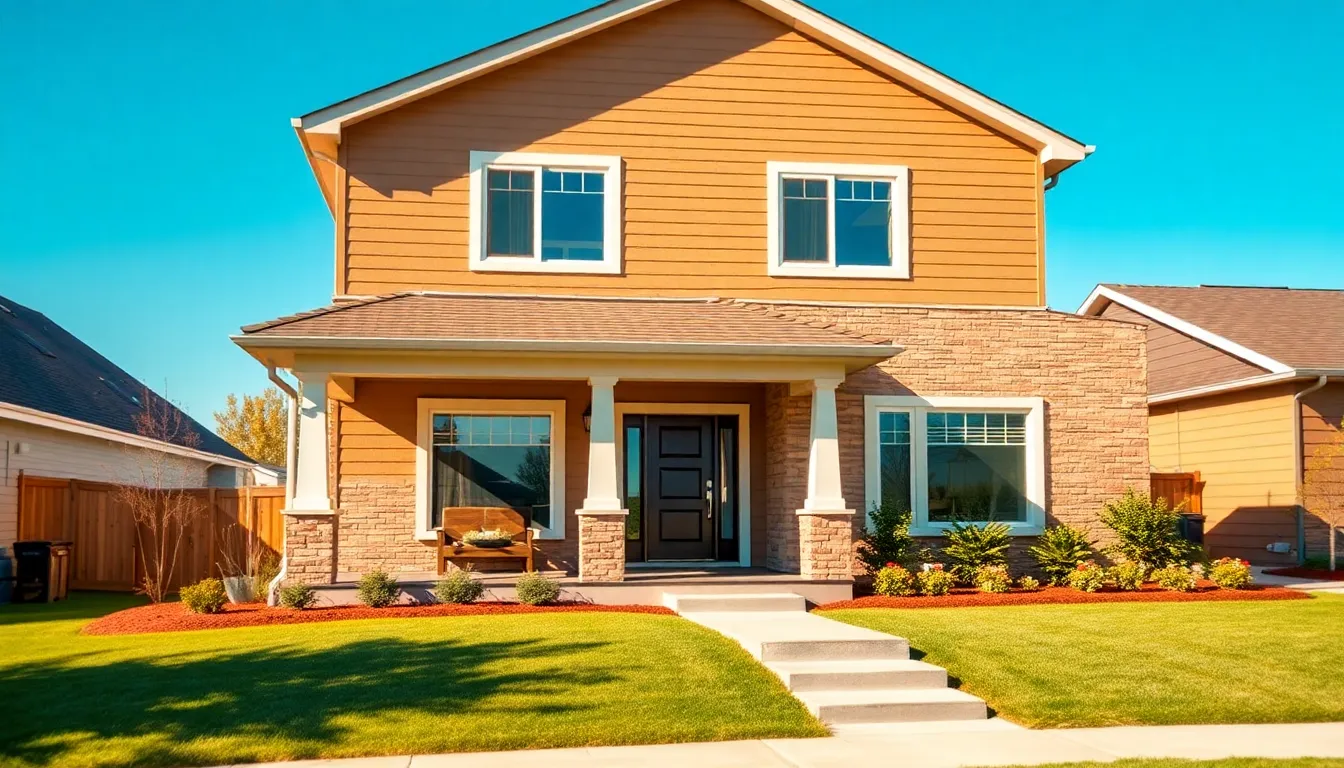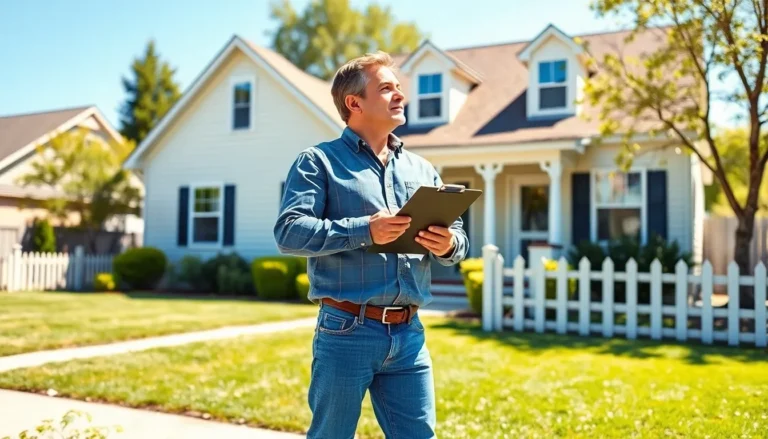Imagine living in a home that not only keeps your family cozy but also saves you money and helps save the planet. Sounds like a dream, right? Welcome to the world of Energy Star Homes, where energy efficiency meets modern living. These homes are like the superheroes of the housing market, swooping in to rescue homeowners from sky-high utility bills and unnecessary energy waste.
With Energy Star certification, these homes boast cutting-edge features designed to keep energy consumption low while maximizing comfort. From advanced insulation to energy-efficient appliances, they pack a punch when it comes to sustainability. So, if you’re looking to upgrade your living situation while giving Mother Earth a high-five, Energy Star Homes might just be your ticket to a greener, wallet-friendly lifestyle. After all, who wouldn’t want a home that’s as good for the planet as it is for their bank account?
Table of Contents
ToggleOverview of Energy Star Homes
Energy Star Homes represent a significant advancement in residential construction, focusing on energy efficiency. These homes utilize state-of-the-art technology alongside strict guidelines to minimize energy consumption while maintaining high comfort levels. Advanced insulation keeps homes warm in winter and cool in summer, effectively reducing reliance on heating and cooling systems.
A variety of energy-efficient appliances enhances sustainability in Energy Star Homes. These appliances consume less electricity or water, directly impacting utility costs. Homebuyers benefit from lower energy bills, as these homes typically outperform standard homes in energy savings. The potential for significant savings attracts environmentally conscious consumers seeking cost-effective solutions.
Energy Star Homes also frequently incorporate renewable energy sources. Solar panels provide additional efficiency, contributing to reduced carbon footprints. Homeowners appreciate the inclusion of these options within the Energy Star certification process, encouraging sustainable living practices. Indoor air quality remains a priority, ensured by efficient ventilation systems that improve overall home environments.
Data indicates Energy Star Homes can reduce energy use by 10 to 20 percent compared to typical new homes. This efficiency translates into fewer greenhouse gas emissions, benefiting the planet and supporting eco-friendly initiatives. Developers often prioritize Energy Star standards to meet the growing demand for sustainable housing.
Energy Star certifications ultimately reflect a commitment to better living conditions. They provide homeowners with reliable guidelines and standards to ensure investments yield both financial and environmental returns. This certification leads to enhanced property values, attracting future buyers interested in energy-efficient living.
Benefits of Energy Star Homes

Energy Star Homes offer numerous advantages that enhance comfort, reduce expenses, and promote environmental sustainability.
Energy Efficiency
Energy-efficient features in these homes significantly lower energy consumption. Enhanced insulation helps maintain consistent indoor temperatures, leading to less reliance on heating and cooling systems. Smart layouts and high-performance windows further optimize energy use. Energy-efficient appliances complement these designs by utilizing less electricity and water, which reinforces overall energy savings. According to the U.S. Environmental Protection Agency, Energy Star Homes can reduce energy use by 10 to 20 percent compared to standard homes. Homeowners enjoy improved comfort while contributing to reduced greenhouse gas emissions.
Cost Savings
Lower utility bills represent one of the most attractive aspects of Energy Star Homes. Families notice marked savings on monthly energy costs due to advanced systems and appliances that use less energy. According to Energy Star, the average household can save around $300 each year on energy bills. Additionally, these homes often qualify for tax credits and rebates, further enhancing financial benefits. Resale values generally increase as buyers prioritize energy-efficient living, making these homes a smart investment. The initial costs may be higher, but long-term savings create substantial financial returns.
Features of Energy Star Homes
Energy Star Homes feature multiple advanced components designed to enhance efficiency and comfort. These elements work together to minimize energy waste while providing a high-quality living environment.
Insulation and Air Sealing
Insulation plays a crucial role in Energy Star Homes. It ensures that the indoor temperature remains stable, significantly reducing heating and cooling needs. Air sealing prevents drafts and allows for optimal indoor air quality. Advanced insulation materials and techniques exceed standard building codes, making homes more effective in avoiding energy loss. These features can lead to energy savings ranging between 10 and 20 percent compared to typical new homes. Ensuring proper insulation and air sealing contributes to a quieter, more comfortable living space.
Energy-Efficient Windows
Energy-efficient windows contribute to the overall performance of Energy Star Homes. These windows use advanced glazing techniques that minimize heat transfer, keeping indoor temperatures consistent year-round. They often feature low-emissivity (low-E) coatings, which reflect infrared light, thereby reducing heat gain in summer and heat loss in winter. Energy-efficient windows can significantly lower utility bills for homeowners, enhancing the appeal of these homes. By incorporating high-performance windows, builders elevate the home’s energy efficiency while increasing natural light indoors and improving aesthetic appeal.
Getting an Energy Star Home
Energy Star Homes offer significant advantages for homeowners seeking efficiency and comfort. The process of acquiring one involves specific steps.
Finding a Certified Builder
Locating a certified builder is essential for obtaining an Energy Star Home. Start by visiting the official Energy Star website, which provides a list of certified builders in various regions. Builders certified by Energy Star have undergone rigorous testing, ensuring they meet energy efficiency standards. They also must follow guidelines that focus on quality construction. Homeowners may consider interviewing multiple certified builders to compare their experience and project portfolios. Asking for references can further validate a builder’s capability.
Understanding Energy Star Ratings
Energy Star ratings indicate a home’s energy efficiency level. Homes receiving this certification typically achieve an energy savings of 10 to 20 percent compared to standard new homes. Ratings depend on various factors, including insulation quality, appliances, and window performance. Each Energy Star Home must undergo rigorous evaluation based on specific requirements set by the program. Buyers should look for the Energy Star label during home searches, which signifies that the property has met the stringent criteria for energy efficiency. Understanding these ratings ensures that homeowners make informed choices aligned with their sustainability goals.
Energy Star Homes offer a compelling option for those seeking a balance between comfort and sustainability. With advanced features that enhance energy efficiency and reduce utility costs, these homes not only support eco-friendly living but also provide significant financial benefits. Homeowners can enjoy lower energy bills while contributing to a healthier planet.
As the demand for sustainable housing continues to rise, choosing an Energy Star Home becomes a wise investment. The combination of modern technology and energy-efficient design ensures long-term savings and increased property values. By prioritizing Energy Star certifications, buyers can confidently select homes that align with their environmental goals and enhance their quality of life.





